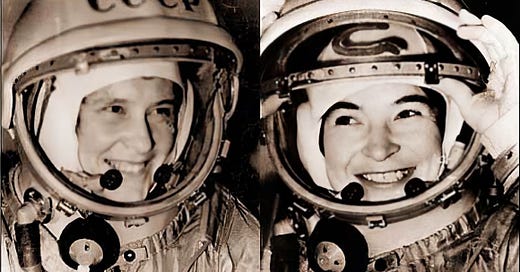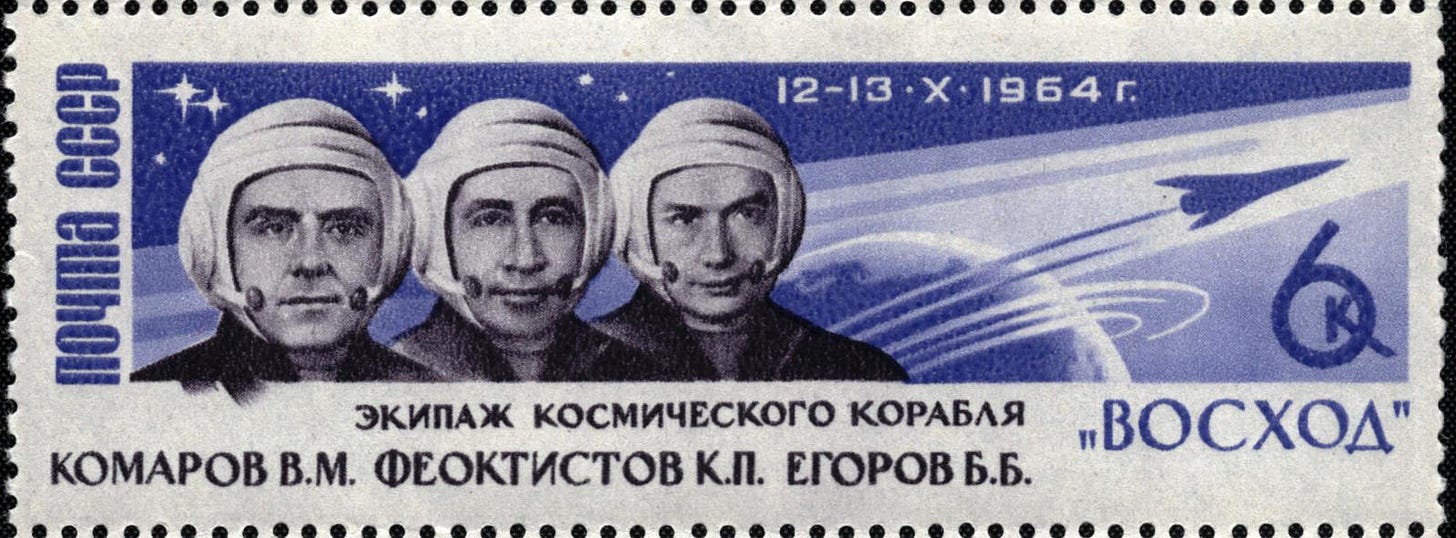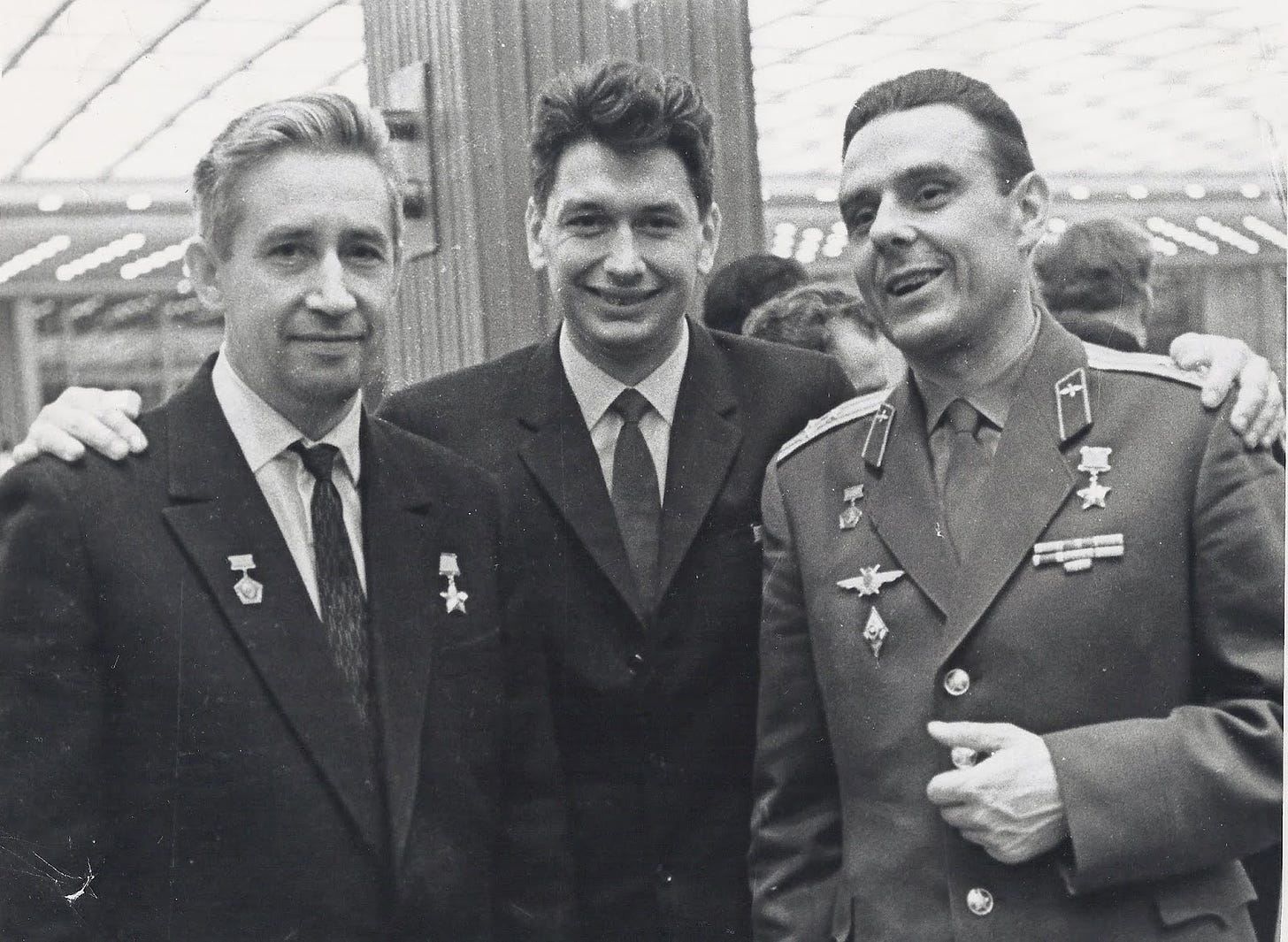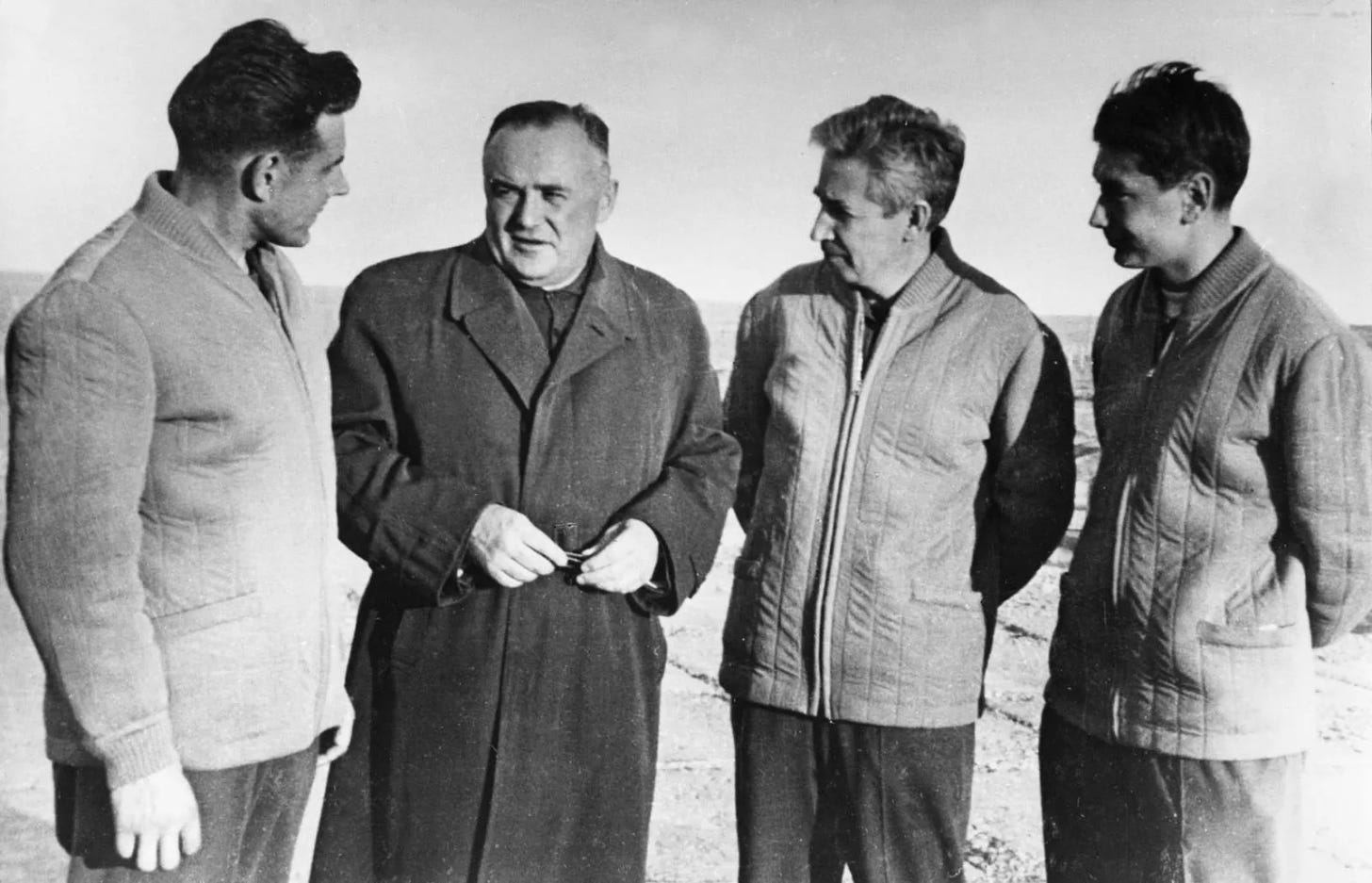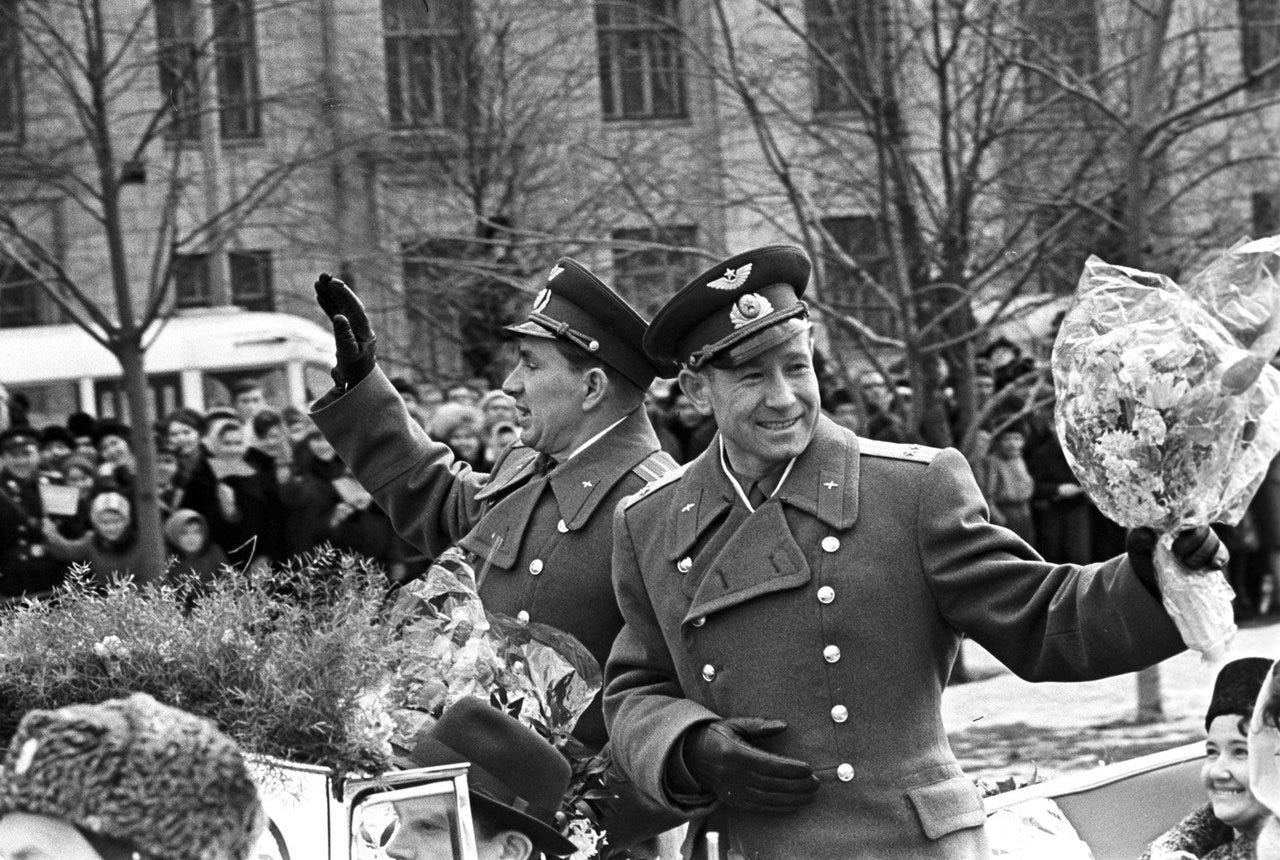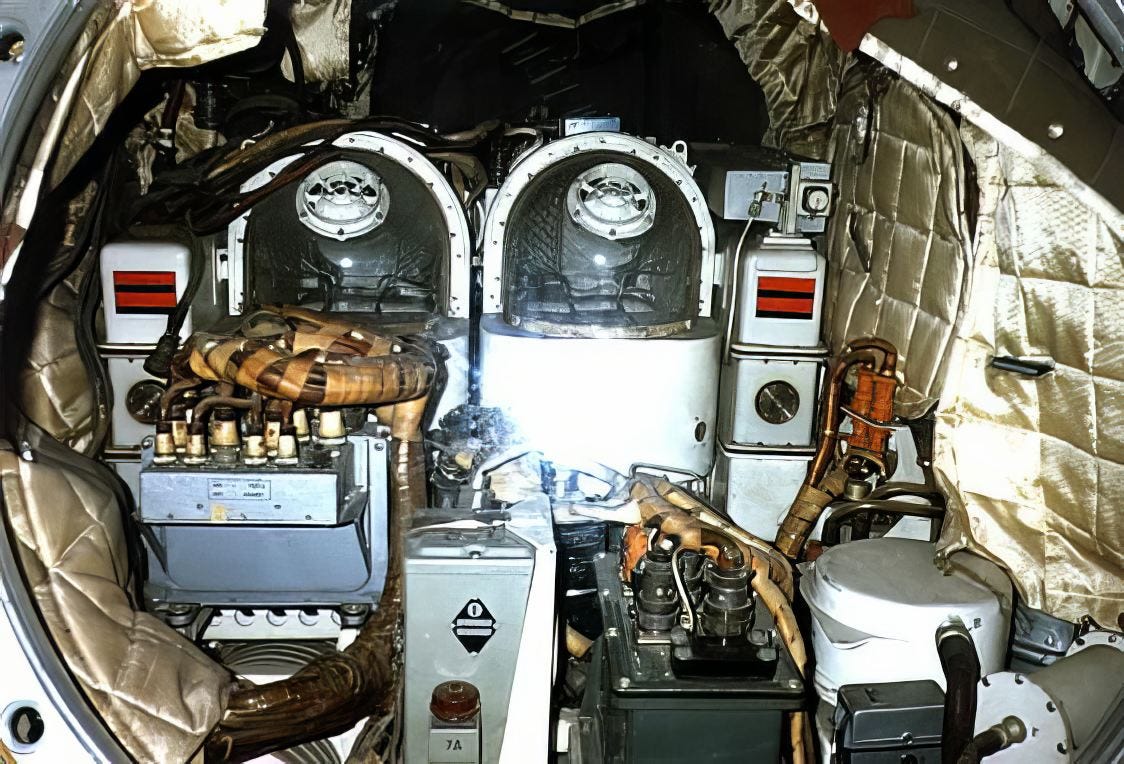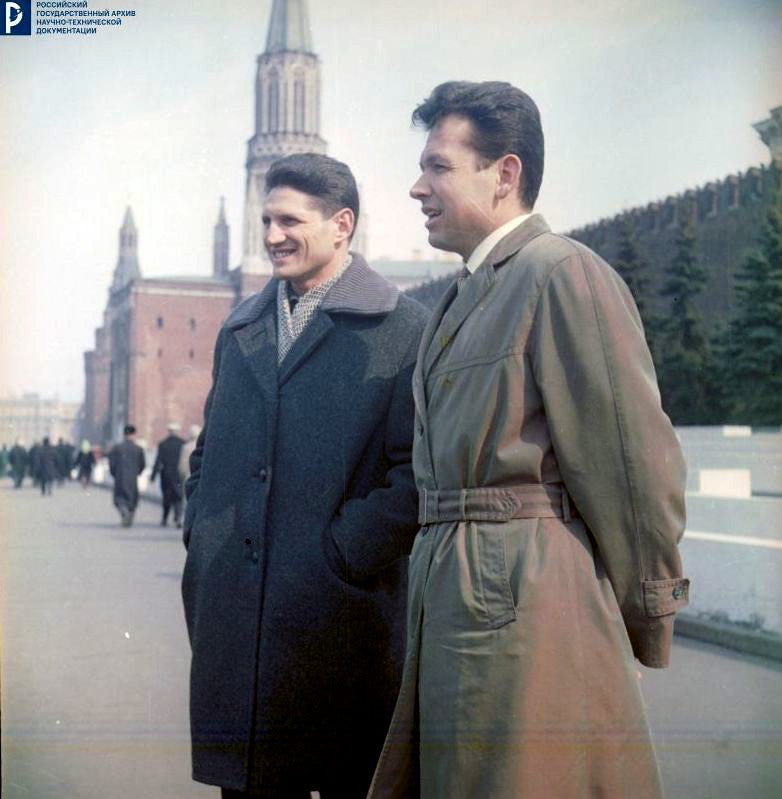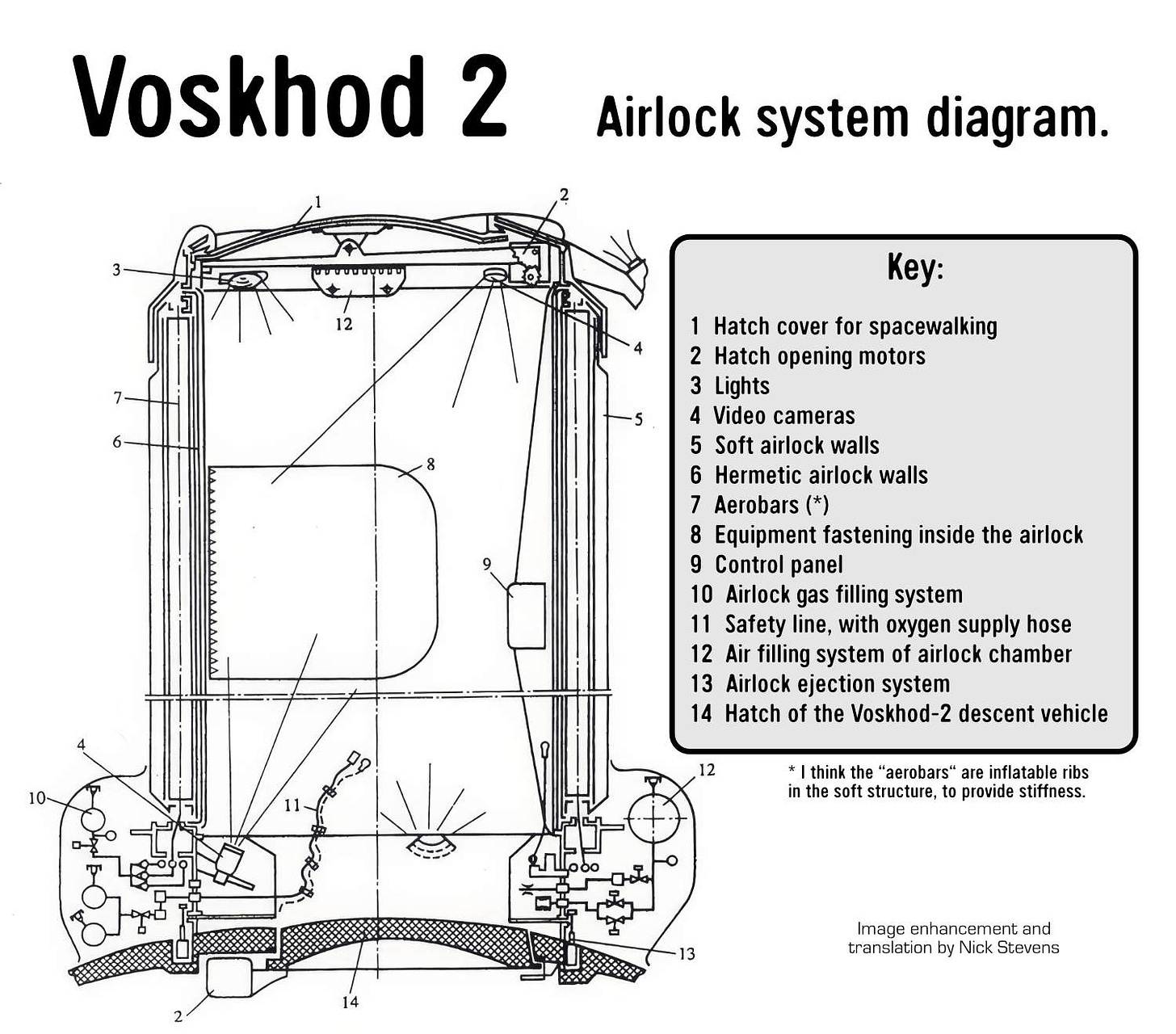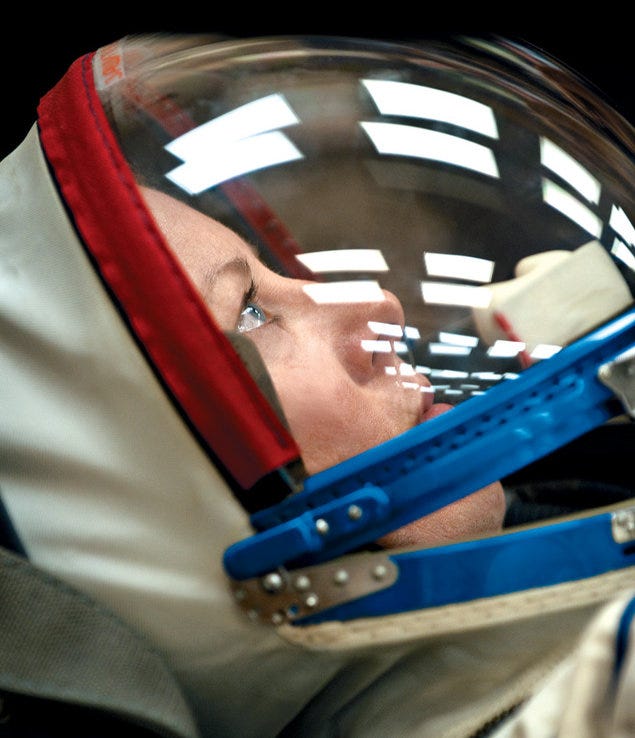A brief overview
The Voskhod, (meaning sunrise), missions were something of a stopgap between the 6 Vostok missions, and the more advanced Soyuz craft. Only two missions were flown, but there were several more planned. Khrushchev saw them as primarily a way to get a few more quick propaganda “firsts”, and get one over on the Americans.
The Voskhod craft could not be depressurised fully, as it was air cooled and would overheat. This meant that an airlock was needed, unlike Gemini. Voskhod crew remained in the craft for landing, unlike Vostok. A rocket system fired just before landing to soften the impact.
For this article I have adopted a different style, combining information from several different sources, with extensive links for more information.
Voskhod 1
Voskhod 1, more properly just Voskhod - As with Vostok the first mission was not given a number. This project was a VERY bad idea, that could have gone horribly wrong. With the dates of the Gemini flights announced, Khrushchev wanted to get 3 men in orbit before the USA managed 2. This was highly reckless, after only 1 unmanned test flight, three people were wedged into the craft, without pressure suits, and with no escape system on the rocket.
There were also arguments about the crew selection:
Via Wikipedia:
The original prime crew of cosmonauts for Voskhod 1, composed of Boris Volynov, Georgi Katys, and Boris Yegorov, was rejected just three days before the scheduled launch date for the space capsule. Katys was reportedly removed after the KGB discovered that his father had been shot during the Great Purge in 1937 and Volynov apparently was the victim of discrimination due to his part-Jewish background, although he would later fly on Soyuz 5 and Soyuz 21.[8]
Politics played a role in the crew's selection. Various factions each supported their own representatives for the flight. Sergei Korolev wanted his engineers to become cosmonauts, believing that spacecraft designers should fly in their own vehicles. The Soviet Air Force agreed to a crew composed of a military pilot, an engineer or scientist, and a doctor, but advocated for an all-military crew. Konstantin Feoktistov, who had been a design engineer for the Vostok, Voskhod, and Soyuz programs, was selected for this flight, becoming the only Soviet outer space designer to make a spaceflight.
Here’s how it’s described on the RGANTD Archive site:
To prepare for the first manned flight on the Voskhod in June 1964, a group of seven candidates was formed. It included: cosmonauts CPC VM Komarov and BV Volynov, design engineer OKB-1 KP Feoktistov, senior researcher at the Institute of Automation and Telemechanics, USSR Academy of Sciences GP Katys, employees of the Institute of Aviation and Space Medicine Air Force BB Egorov and VG Lazarev. The group also included the CPC doctor A.V. Sorokin. The candidates were preparing for the flight in different crews, as General N.P. Kamanin, S.P. Korolev and M.V. Keldysh for a long time could not agree on which of them to send to space flight.
N.P. Kamanin believed that the commander of the main crew should be B.V. Volynov, as he had already been the understudy of the Vostok-3, -4, -5 pilots three times. However, on 9 October 1964, the State Commission appointed V.M. Komarov, K.P. Feoktistov and B.B. Egorov to the main crew of Voskhod. The other candidates were included in the backup crew. B.V. Volynov became a backup crew for the fourth time.
On 6 October 1964, the first unmanned spacecraft 3KV (factory No. 2), officially named Cosmos-47, was launched. Instead of cosmonauts, three dummies were on board. A day later the ship successfully landed near Kustanai. The test of the 3KV spacecraft was successful.
On 12 October 1964, the world's first three-seat manned spacecraft Voskhod (3KV No. 3) was launched. Cosmonauts V.M. Komarov, K.P. Feoktistov and B.B. Egorov flew into space for the first time in the world without spacesuits, but only in flight suits. During the 24-hour flight they fully completed the programme of scientific and medical experiments.
RGANTD
Between Voskhod 1 & 2.
This info via astronautix.com.
1965 Mar 5 - Voskhod plans Spacecraft: Voskhod.
Kamanin receives a copy of Korolev's "Preliminary Plan for Voskhod spacecraft (3KV and 3KD) series in 1965", issued in February. His plan is:
3KV Number 5 - to be completed in June, launched by August, an unmanned biological flight with life forms, to be kept in orbit for 15-30 days, with experimental equipment in the cabin to monitor the organisms and a self-destruct system
3KV Number 6 - to be completed in August, and flown by October on a 15-day mission with a two-man crew: a flight commander and scientist
3KV number 7 - to be completed in December, and flown by April 1966 on a 15-20 day mission with a pilot and physician aboard. The spacecraft would also conduct artificial gravity experiments for 3-4 days of the flight
3KD numbers 8 and 9 - a prime spacecraft and a backup, fitted with the airlock system. A spacecraft commander and pilot would make a flight or flights of 3 to 5 days. 2 or 3 spacewalks would be conducted on each flight, with the EVA cosmonaut using a manoeuvring apparatus to back away as far as 50 to 100 m from the spacecraft. Manually controlled landing of the capsule would also be demonstrated.
Note in particular the “Artificial Gravity Experiments” for number 7. This would involve a tethered Voskhod, spun to provide the effect of gravity.
Voskhod 2.
Down to 2 cosmonauts, for the mission that accomplished the worlds first spacewalk, by Alexei Leonov. This has been thoroughly described elsewhere.
Museum video:
The airlock is a reproduction, the main craft is the flown item.
Spacewalk preparation video:
Voskhod 3.
This mission was well advanced in preparations, but when Khrushchev was kicked out, the whole thing was cancelled, and focus shifted to moving forward with Soyuz and the Lunar program.
Again, here’s the view from the RGANTD State archive:
On 3 May 1965, the cosmonauts of the two groups began direct preparations. The report (L. 17) shows the specific compositions of the three crews that underwent flight training on the Tu-104 flying laboratory on the Voskhod-3 flight programme: B.V. Volynov - G.P. Katys, G.T. Beregovoy - L.S. Demin, V.A. Shatalov - V.G. Lazarev. Military doctor V.G. Lazarev was included in the third crew, because in one of the Voskhods flights it was planned to conduct a series of medical experiments, including the first surgical operation on a guinea pig in space flight conditions.
In December 1965, due to changes in the manufacture of the spacecraft, the Air Force Command decided to re-form the crews for the Voskhod-3 flight. The primary crew consisted of B.V. Volynov and G.S. Shonin, and the backup crew consisted of G.T. Beregovoy and V.A. Shatalov.
The main purpose of the Voskhod-3 (3KV No. 6) flight was to perform a long space flight of 18-20 days, a record for those times. The crew was to perform many physical-technical, military-applied and medical-biological experiments. In particular, it was supposed to carry out an experiment with the "Lead" apparatus to detect ballistic missile plumes.
On 22 February 1966, the spacecraft ZKV No. 5 "Kosmos-110" was launched with dogs Veterk and Ugolk to test the operation of onboard systems during a long orbital flight. After 22 days of flight, the ship successfully landed.
On 28 February 1966, the crews of Voskhod-3 completed flight training and passed examinations. On 12 March the State Commission approved the crews: the main crew - B.V. Volynov and G.S. Shonin, the backup crew - G.T. Beregovoy and V.A. Shatalov.
However, the tests of the onboard life support system (LSS) for a full mission (20 days) were delayed. It was necessary to improve this system. The launch of Voskhod-3, scheduled for 20-23 March, was first postponed to April and then to the end of May 1966.
On May 10, 1966, at the meeting of the Military-Industrial Commission, a proposal to cancel the Voskhod-3 flight was voiced for the first time. It was explained by the fact that such a flight would not bring anything new. Especially if it would not be possible to perform a long flight. In addition, work on Voskhod-3 began to interfere with and distract from work on the newest Soyuz spacecraft (7K-OK).
On 12 May, after a long discussion, the State Commission did not make a decision on the launch. Probably, a certain role was played here by the fact that the launch of Voskhod-3 was to be the first without S.P. Korolev, who died in January 1966. Of course, Sergey Pavlovich's opinion on the launch of Voskhod-3 would have been decisive. This is where the story of the Voskhod spacecraft flights ends.
RGANTD
Now after Voskhod 3 it gets a bit vague - some say the program elements were not yet tied to specific flights. So take these details with a pinch of salt!
Voskhod 4
A similar long duration mission to Voskhod 3, but with only one cosmonaut. My guess is that this would be to allow life support for the maximum length of time in orbit.
Voskhod 5
The numbering might be incorrect, but this was the most likely slot for the mission with two female cosmonauts.
Again via RGANTD:
In the RGANTD in the funds of the CPC named after Yuri Gagarin was another interesting document - Programme of direct training of female cosmonauts CPC for space flight on a satellite ship 3KV (F. 1. Op. 13-1. D. 40). The document was approved on 8 February 1966 General NP Kamanin.
The programme provided for the training of two female crews in the following composition: the primary crew - V.L. Ponomareva and I.B. Solovyova; the backup crew - J.D. Sergeichik (Yerkina) and T.D. Pitskhelauri (Kuznetsova). The head of the group was Major V.V. Nikolaeva-Tereshkova.
Very interesting to see that Valentina Tereshkova is group head of the women’s cosmonaut squad.
Voskhod 6 and Voskhod 7
Unspecified military missions.
Summary by Nick
For me, the Voskhod series is where it all went wrong for the USSR. Voskhod 2 was the last of the nonstop “firsts”, where the USSR was getting all the records. The slower but more methodical pace of the Americans started to pay off, and by the time Voskhod 3 could have flown, it would not have beaten the endurance record set by Gemini. While Gemini only had 2 crew, it was a MUCH more capable craft, and putting 3 people into a Voskhod was a dangerous stunt, with no value beyond propaganda.
By the end of the program, the Soyuz spacecraft program was underway, but being rushed, with tragic results. And Korolev had died in a botched operation.
Voskhod 2’s spacewalk was not just an impressive “first”, but as many mission concepts required spacewalks between craft, it delivered valuable knowledge. It was the high point of the early Soviet Space program. It would be many years before the next ground-breaking achievement in space by the Soviet Union.
Cool links:
Several links to sources of info used for this article. Some may not work for you, depending on your location.
Blog post on female cosmonauts
Roscosmos video on Voskhod, (on the “Dzen” video site)
Good history on early female cosmonaut plans. Astronautix.


